Contents
- Crop Cultivation
- Agricultural Communities
- Festivals/Rituals Related to Farming
- Agera
- Types of Farming
- Salt Farms
- Labor and Challenges
- Terrace Farming
- Tribal Farming
- The Grow More Food Initiative
- Traditional Agricultural Practices
- Institutional Infrastructure
- Graphs
- Irrigation
- A. No. of Projects
- B. No. of Ponds/Vilage Lakes and Storage Dams
- C. Tubewells and Pumps Installed In The Year
- D. Irrigation and Water Pumping Facilities
- Cropping Metrics
- A. Distribution of Chemical Fertilizers
- Land Use and Credit
- A. Agricultural Lending
- B. Agricultural Credit as a share of Total Credit
- Sources
MUMBAI SUBURBAN
Agriculture
Last updated on 6 November 2025. Help us improve the information on this page by clicking on suggest edits or writing to us.
Mumbai's agricultural heritage is often overshadowed by its bustling urban environment, yet it remains an integral part of the city's identity. Historically, as the gazetteer says, areas like Bombay Suburban, particularly South Salsette, maintained a rural character well into the nineteenth century, with significant farmland dotting the region. While the rapid march of industrialization and urban expansion in the late 1800s began to reshape this landscape, pockets of agriculture continue to thrive against the odds even today.
Crop Cultivation
The colonial district Gazetteer (1909) offers a captivating glimpse into the agricultural richness of Greater Bombay, where a diverse array of crops and trees, such as tamarind, jackfruit, ber, rice, and coconut palms, flourished in the habitations of local communities. Rice emerged as the island's staple crop, but the rapid rise of factories and urban development steadily encroached on these agricultural lands.
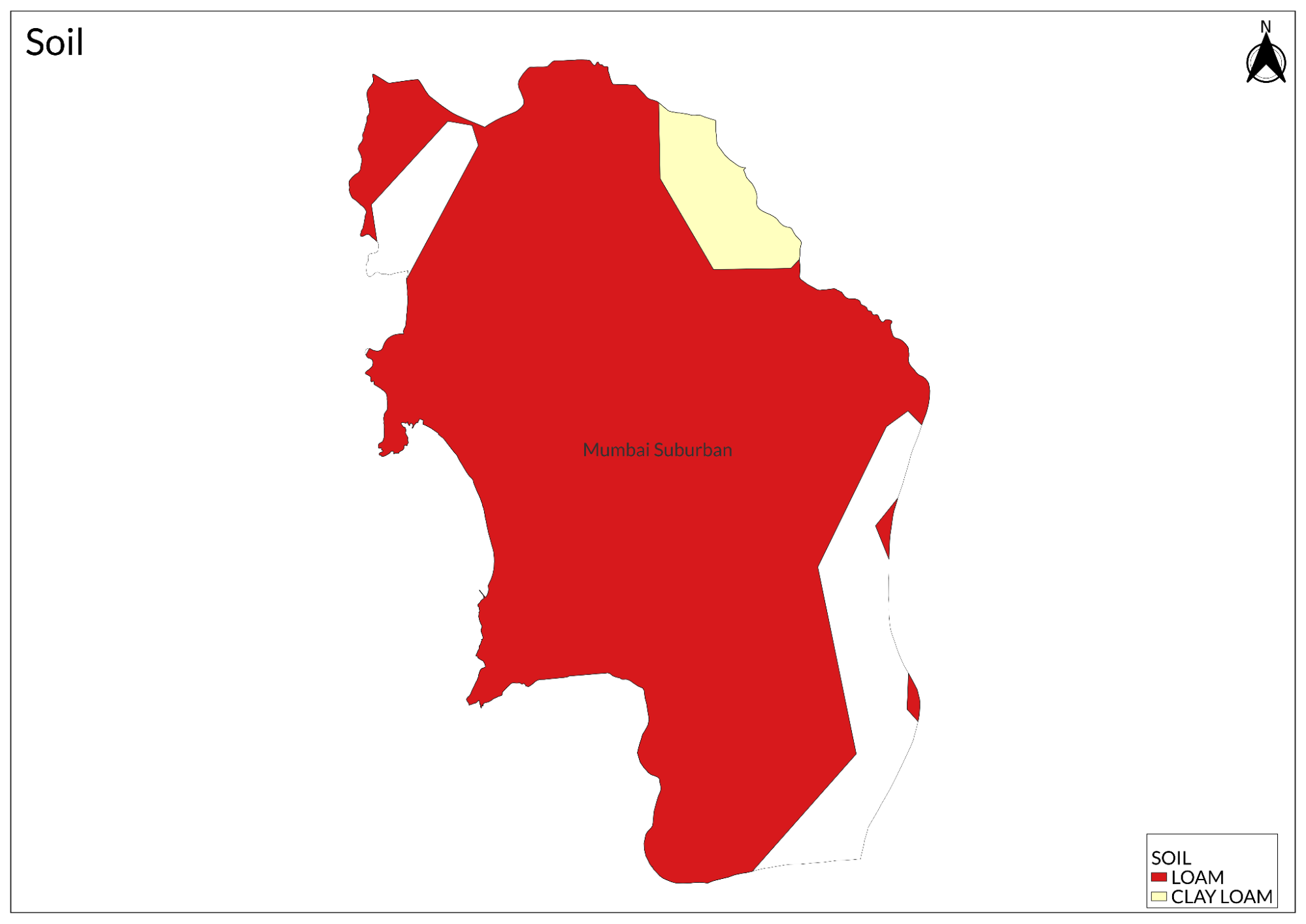

In Greater Bombay (Mumbai Suburban), as the gazetteer notes, rice, fruits, vegetables, and coconuts were commonly cultivated, but mangoes truly stood out, especially around Trombay. The Portuguese developed a particular fondness for these mangoes, which became famous in the seventeenth and eighteenth centuries.
The area dedicated to mango cultivation in the Bombay Suburban District saw impressive growth, even in the post-independence era, expanding from approximately 324 hectares in 1950-51 to 500 hectares by 1975-76. This increase underscored the mango’s importance as a commercial crop. Farmers adopted methods similar to those used in Thane, applying manure to young trees to promote healthy growth. Typically, mango trees begin bearing fruit after about six years, with optimal yields expected from the tenth year onward. Locals fondly recalled the presence of these mango trees in Aarey during the mid-nineteenth century.
In addition to fruit cultivation, salt farming played a significant role in the local economy. Advait Keni, a young member of the Koli community and a passionate documenter of local history, spoke of a practice known as Fattemari in Bhandup. This involved shipping locally produced salt to Thane for export to global markets. After the British replaced Maratha rule in Salsette in 1818, they focused on maximizing profits from Bhandup’s salt production.
However, as the town expanded in the early nineteenth century, agricultural development faced increasing challenges. The Greater Bombay Gazetteer (1986-87) notes that while rice cultivation remained significant, it gradually declined. Garden cultivation continued to thrive, yielding abundant crops of brinjals and other vegetables. Yet, the burgeoning economic growth repurposed much of this land for railways and buildings, further reducing available agricultural space.
Agricultural Communities
According to the colonial Gazetteer of Thana district (1882), the agricultural population in Salsette, now part of Greater Bombay, included groups such as the Kolis, Sonkolis, Christians, Kunbis, and Agris. By 1750, as the gazette notes, many of the proprietors and cultivators who farmed coconut groves, rice fields, and onion crops in Bombay were Roman Catholic Mestizos and Canarins, likely referring to the East Indian community.
The East Indians are an indigenous community with deep agricultural roots that persist today. In areas around Sanjay Gandhi National Park (SGNP), many farmers belong to communities like the Warli, Mahadev Kolis, and Katkari, continuing a tradition that dates back centuries. Historical studies even suggest that monks residing in the caves of Kanheri and Magathane engaged in farming, underscoring the long-standing agricultural heritage of the region.
The Agris and Kharvi Kolis are two communities closely associated with salt farming in the region. The name "Kharvi Kolis" is particularly telling, as it originates from the word "Khar," which means salt, highlighting their traditional occupation.
Bhandup played a crucial role in salt production on Salcette Island, featuring numerous salt pans along the Thane Creek. As the British expanded salt production, they brought the Kharvi Kolis from Gujarat to the area, granting them land near Koliwada to establish their settlement and continue their work in salt farming.
Festivals/Rituals Related to Farming
Agera
Agera is a harvest and thanksgiving festival celebrated by the East Indian community on the first Sunday of October. The name "agera" comes from the Latin word "ager," meaning "field." While the community has become increasingly alienated from its agricultural roots, Agera remains indicative of those origins.
In the days when sustainable farming was their primary occupation, Agera was a straightforward indigenous celebration steeped in tradition, expressing gratitude for the harvest. On the morning of Agera, the parish priest leads a procession of farmers to a nearby field, where he blesses the paddy and cuts a few stalks as part of the ritual.
Types of Farming
Salt Farms
Before salt reaches consumers in neatly packaged forms, it undergoes a fascinating journey, cultivated and harvested from salt farms. Mumbai has a long history of salt cultivation, with early references, when Ferishta, a historian mentioned "salt made in Thane creek and sent in bags to Devgiri and other Deccan centers." Vinayak Parab () from the Mumbai Research Centre of the Asiatic Society highlights this historical significance, noting, “Mumbai was always known for its salt pans. From Shivaji Maharaj to the British, everyone had an interest in this region because of its salt pans.”
Lying on the fringes of the Mulund-Airoli road, salt farms nestled in this region have endured for over a century, their existence sustained by 100 leases granted by the British government to Indian businessmen and landowners (zamindars).
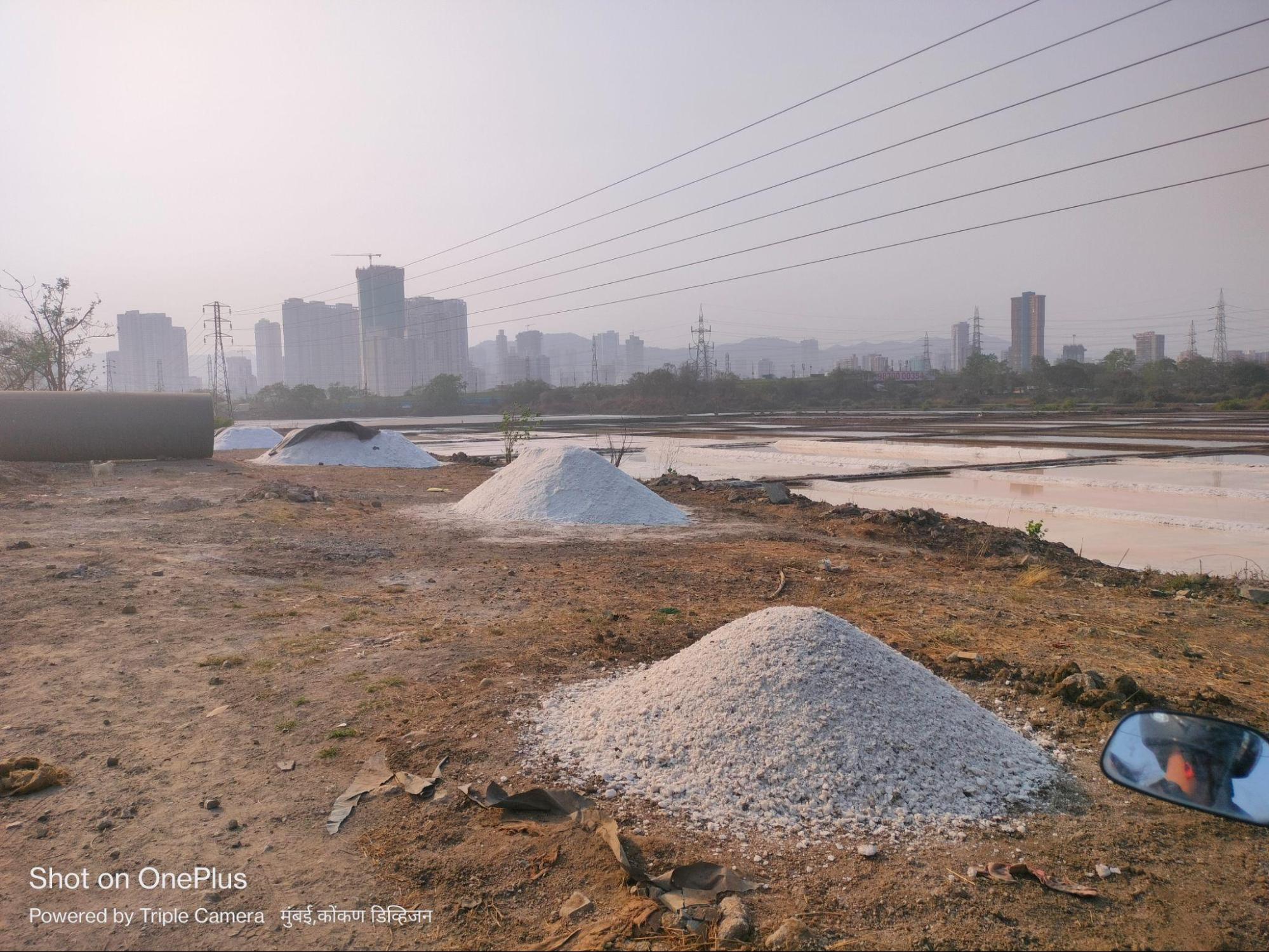
The process of salt production within the salt pans unfolds after the monsoon season, when the salt farmers start the process by removing the excessive rainwater that fills the pans. After the water recedes, the Sisyphean cycle of flattening the soil begins. Mud fields are plodded to bring out the briny/saline groundwater as shallow pans are simultaneously created through segregations created by wet mud. For irrigation, additionally, water from streams/bawadis (well-like structures) is channeled into the water pathways/margs into the shallow pans where the natural evaporation process then takes place.
Over five to ten days, the sun evaporates the water, resulting in the crystallization of raw, unrefined salt. Skilled workers then meticulously harvest the salt using traditional tools like rakes, khurpis, and dantaalas, preserving a legacy passed down through generations. The salt produced in these pans includes varieties like Karkaj (mota namak), maapi, and kapri (chapta namak), which are processed and sold to various industries. The salt pans also play a crucial role in flood prevention, serving as natural barriers alongside mangroves, and are protected by strict Coastal Regulation Zone rules.
Salt farming occurs from November to June, with crude salt harvested during the summer months. The area remains barren for the rest of the year, with no other agricultural activities taking place.
Labor and Challenges
“Pehle namak ke agar mei gulaam ki tarah kaam karna padta tha,” Vrujhlal Mithna, a salt farmer, remarks. In the collective memory of this region, labor for salt farming intertwines with the railway expansion projects that took place during colonial rule. In vast expanses of land that were jungles, tribals from Gujarat and Maharashtra were brought in as laborers. Agricultural laborers faced significant challenges, particularly regarding water availability, around 50 to 60 years ago. They relied on sources like well water (irrigation channels) and water from naalas for their needs.
“Kharcha zaaste ani parvadat nahi,” Mithna comments. Production decreases during this time as salt production depends on sunlight. Unlike factories, agricultural farms lack shelter or any type of cover, leading many laborers to return to their villages, typically during the monsoon season. Salt farming entails significant physical labor and hardship, with both men and women enduring extreme physical discomfort, including aches, foot injuries, heat stress, and skin and eye problems. These challenges have led many to discourage the younger generation from pursuing or continuing the profession of farming. Additionally, industrial labor is supposedly a more economically secure and viable path for many.
A positive change in the olden methods can be observed in the lives of the laborers during the rainy season.
Earlier, farmers used to struggle to safeguard the farms, with two individuals often remaining behind to protect the land from waterlogging by covering and fastening the corners and pans with sheets.
Salt farming faces several challenges. One big problem is that “aata Mumbai madhe kutha zaaga pan naahi” (there's not enough land available). Recently, the Bombay High Court ended leases for salt pan lands covering 782 acres in places like Mulund, Bhandup, and Kanjurmarg. BMC, for a long time, had been eyeing the area for its road widening project. Furthermore, the state's proposal to utilize salt pans in Bhandup-Kanjurmarg as part of the Dharavi redevelopment adds to the land-related challenges.
Concretization is another issue that has adversely affected not only the farms but also farming in itself.
With increasing concretization, streams have turned into naalas, causing major harm to the natural irrigation sources and processes.
Terrace Farming
Growing vegetables and fruits doesn't require vast fields or forests; they can thrive in apartment complexes and society terraces. Aarti Chauhan's success in organic terrace farming in Mulund exemplifies this potential within Mumbai's urban landscape.
In 2016, while serving as her society's secretary, Aarti initiated composting efforts after the BMC promised a 5% property tax rebate for green waste management—a pledge that remains unfulfilled. By 2017, she invested ₹15,000 in soil and seeds, transforming her building's terrace into a productive farm.

When asked about her harvest, Aarti confidently replied, “Ask me what I haven’t grown.” Over six years, she has successfully cultivated spinach, corn (Makka), beetroot, muskmelon, bitter gourd, broccoli, pomegranate, red amaranth, and many other crops.


Aarti's harvesting season begins three months after June. She employs organic farming methods, using compost as fertilizer. Her society generates at least 25 kg of waste daily, which she meticulously segregates into wet and dry categories. This waste is stored in pits for over a week to create nutrient-rich compost.
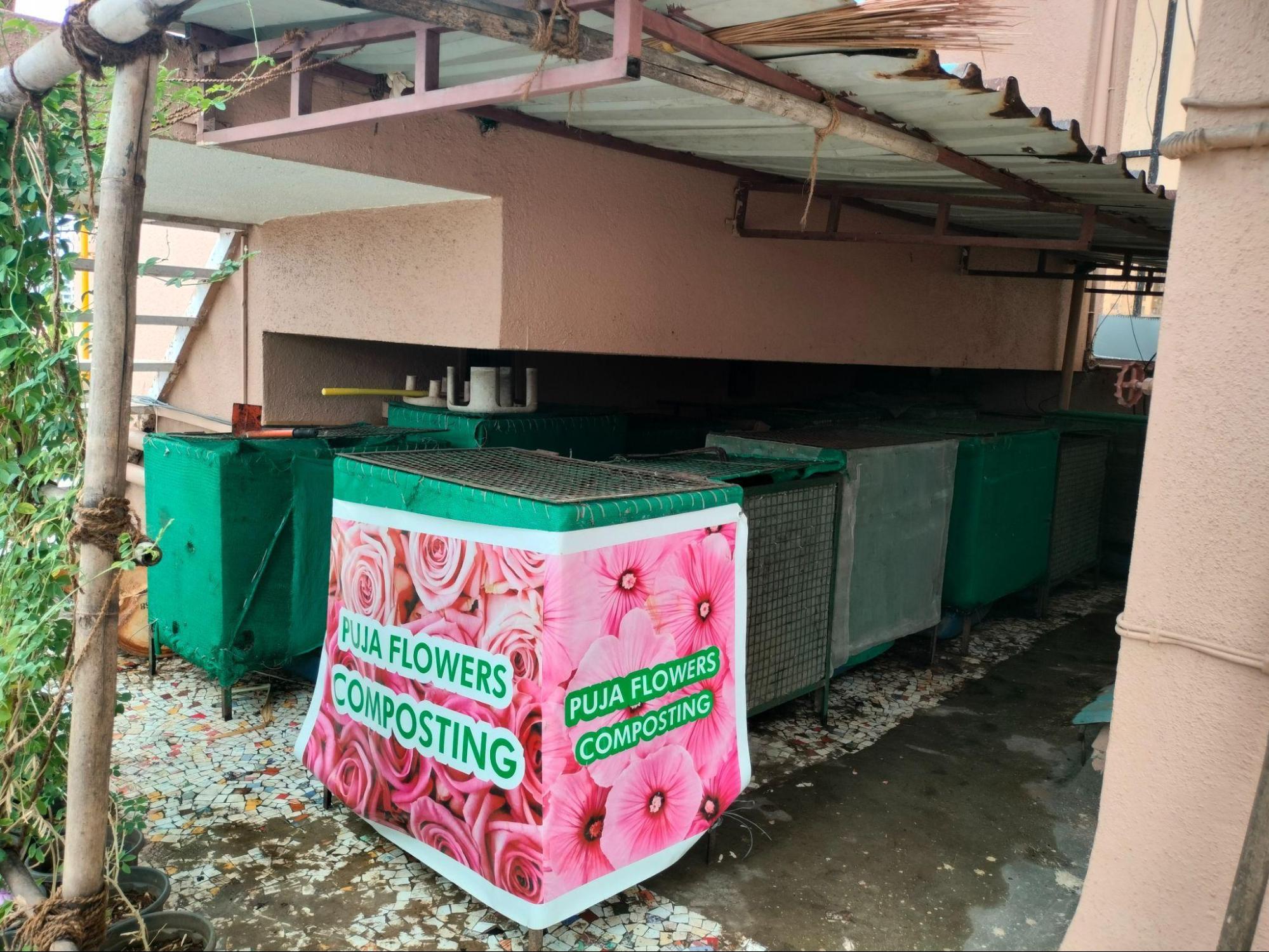
To further enrich the soil, Aarti mixes in sadaphuli, jhendu, and neem powder. Today, to grow new crops, Aarti doesn’t need to buy new soil. While potting new crops, she lays beneath the soil dry leaves, coco peat, and rice husk to keep it light.
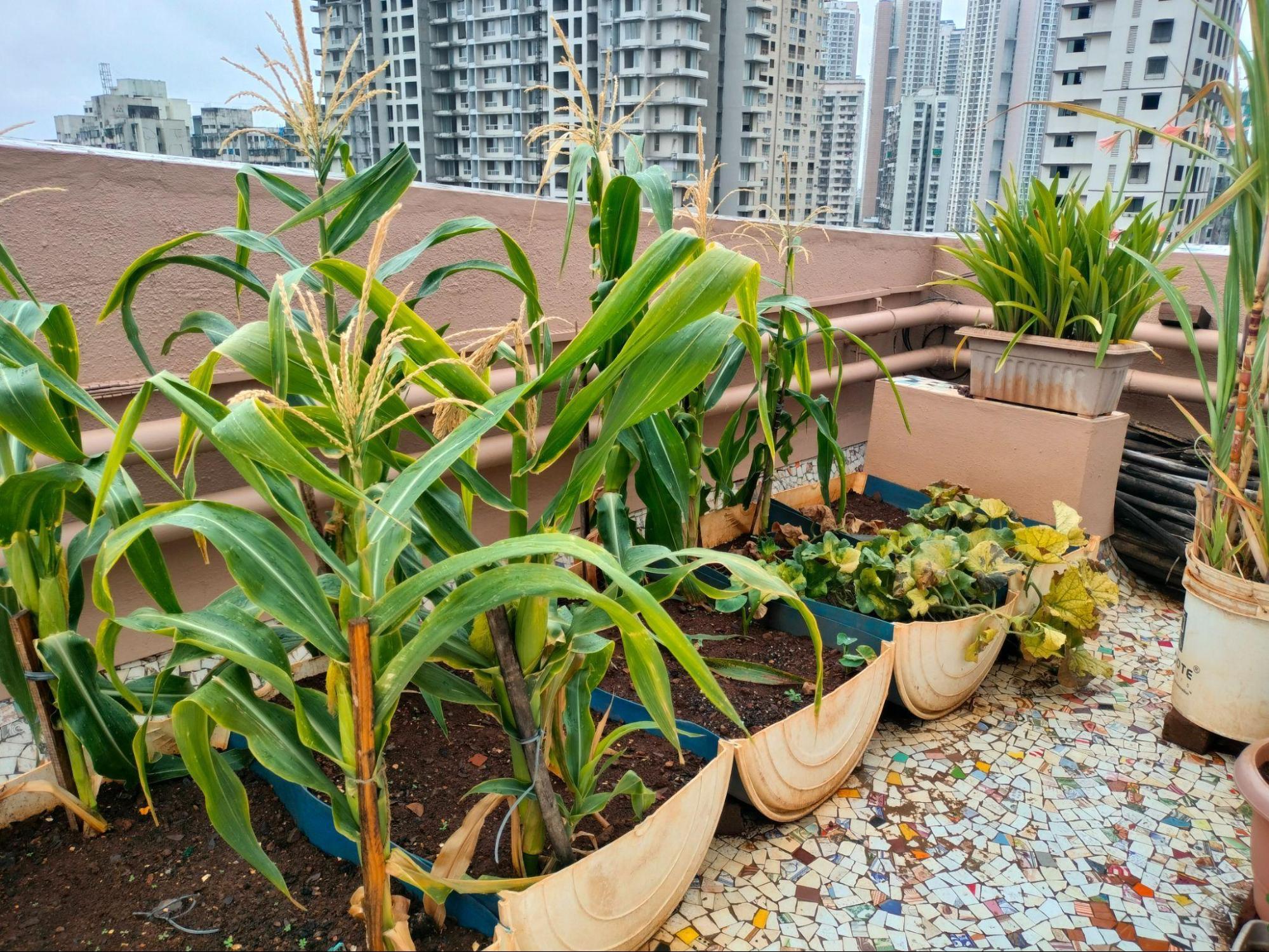
Aarti emphasizes that “every square foot should have a load-bearing capacity of 18 kg.” Growing her crops within, Aarti underscores the importance of cleanliness and waste segregation as primary for the success of a terrace farm.
Although leakage isn’t typically an issue caused by the terrace farm—unless the building has existing structural risks—it’s wise to assess the building's strength before starting a terrace garden. To mitigate any potential risks, Aarti elevates her pots using bricks and bamboo. She also keeps her crop beds mobile, avoiding fixed installations. This approach not only enhances mobility but also facilitates individualized care for each plant.
Instead of relying on drip irrigation, Aarti manually waters her crops using pipes. She emphasizes the need to water at least twice a day, attributing this requirement to the differences between the soil in agricultural fields and the concrete environment of terrace farms.

Aarti has creatively repurposed rice bags, drums, and paint buckets to create beds and pots for her crops. “Grow your vegetables,” she encourages, believing in the endless possibilities of terrace farming in Mumbai, where every building has a terrace.
The benefits that Aarti’s society residents have experienced are many, especially among senior citizens. The freshness and nutrition of these organic vegetables and fruits have enabled many to eat vegetables like spinach, which they couldn't before, and also caused improvement in their digestion.
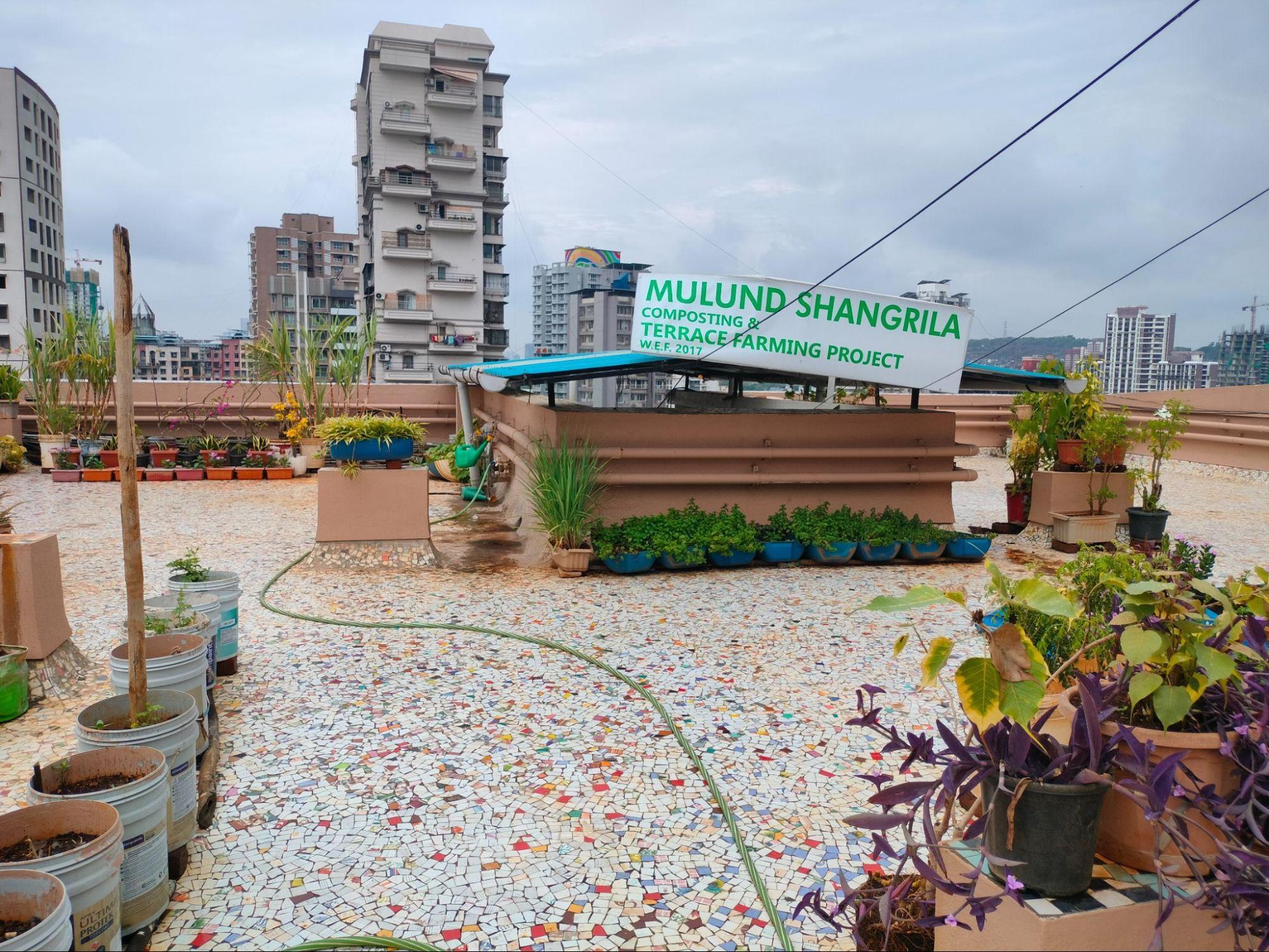
Vegetable growth spans 90 days, with leafy varieties ready in 25-40 days. Aarti recommends buying seeds from shops that lie amidst the agricultural farms. The seeds she has bought are from Vashin, a locality that falls in the Thane district. Some vegetables, such as capsicum, she states, due to the climate of Mumbai, don’t grow perfectly unless maybe you create a greenhouse. Still, terrace farming can be cost-effective by integrating the above techniques and by further encouraging collective efforts amongst society members.
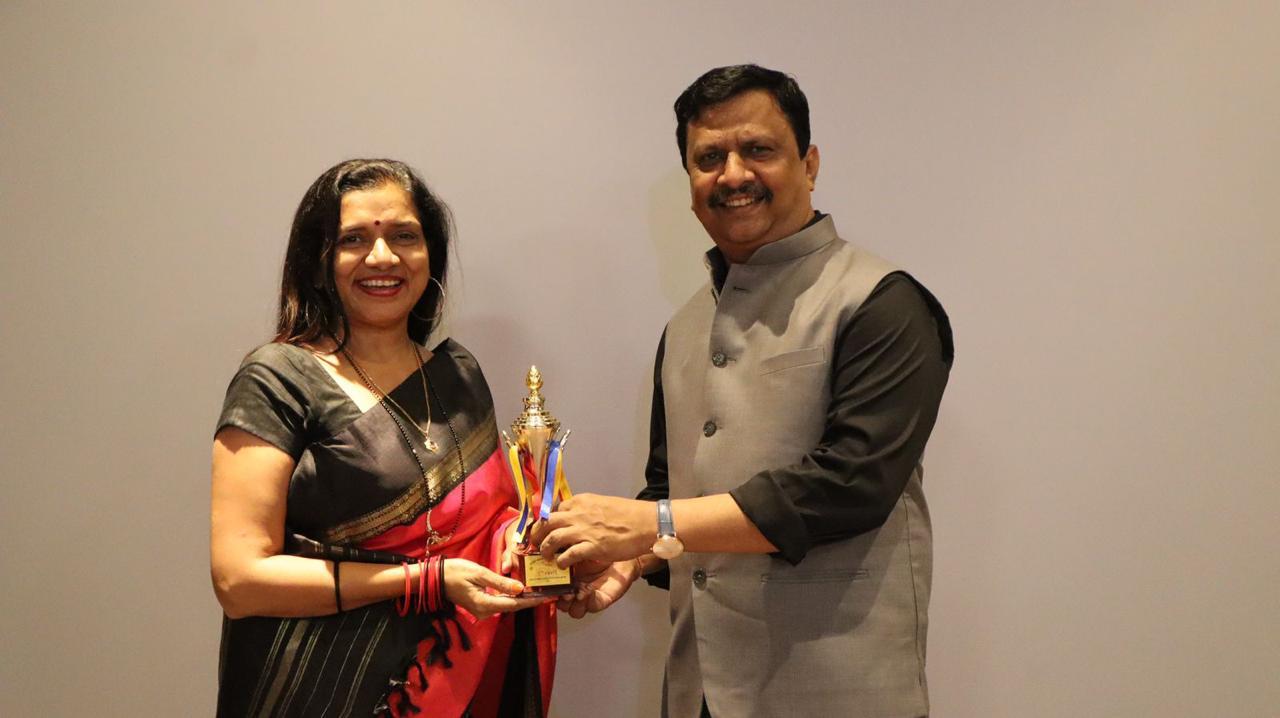
Like any other agricultural farm, immense interest, care, affection, and toil are a part and parcel of the farming process. For her efforts, Aarti received an award from BMC in 2019 for her cultivation efforts, placing second just after the colossal corporation, Godrej. Today, Aarti receives aid of 4K from her society to cultivate crops alongside donations from residents. Additionally, Aarti works in collaboration with Hariyali Foundation, an NGO known for advocating sustainable practices and green initiatives among many other things, and often delivers seminars on Terrace Farming in their exhibitions and programs in Mumbai.
This terrace farm, cultivated and maintained by Aarti and her housekeeper, Lakshmi, laboriously and delicately, stands as a testament to the many possibilities of keeping agriculture, greenery, and self-sufficiency alive amidst the ever-growing concrete jungle that is Mumbai.
Tribal Farming
Tribal farming in Mumbai, particularly within areas like Aarey Colony and Borivali, has a rich history intertwined with the lives of the adivasi communities. As urbanization encroaches upon their lands, these generational farmers, fishers, and livestock rearers face significant challenges. With approximately 27 to 29 tribal hamlets housing over 10,000 Adivasis, Aarey remains a green oasis, home to diverse crops cultivated using traditional methods. Farmers often utilize natural fertilizers, like water from cattle sheds, reflecting a sustainable relationship with the environment.
Prakash Bhoir, a local activist and artist, emphasizes the importance of this land, stating that the community historically sourced their dietary needs from the forest. Now, they cultivate paddy, vegetables, and fruits like bananas, guavas, and mangoes, adapting to the changing landscape while holding onto their traditions.
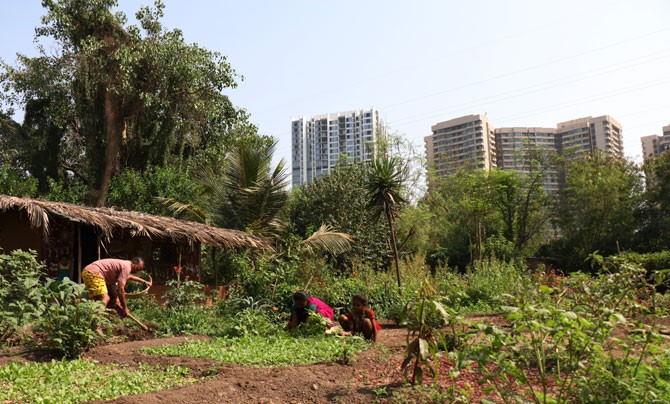
The article titled “Tribal Family’s Battle to Protect Ancestral Land”, written by Sherine Raj (2023), describes the case of Kusum, which sadly reflects the experiences of many tribal farmers in these forests. Kusum mentions that the farmland, belonging to her husband, Kisan Bhagat, has been cultivated for generations, yielding rice and vegetables annually.
Amrita Bhattacharjee, an environmental activist from the Aarey Conservation Group (ACG), highlights that despite living in the same area for generations, many tribal individuals lack the necessary paperwork to claim ownership of their land, and some do not even have registered identity proofs.
The absence of legal documentation and the socio-economic challenges faced by tribal communities have led to increased cases of land poaching and displacement. This widespread issue prompted the implementation of the Forest Rights Act (FRA) in 2006, which “recognizes the rights of the forest-dwelling tribal communities and other traditional forest dwellers to forest resources, on which these communities were dependent for a variety of needs, including livelihood, habitation, and other socio-cultural needs.” Despite this legislation, Kusum Bhagat continues to fight for her ancestral farmland, a struggle that highlights the deep-rooted injustices and corruption within the system.”
While government initiatives like the Pradhan Mantri Kisan Yojana and Jan Dhan Yojana exist to support farmers, many NGO workers observe significant gaps in their effectiveness. Soma Dutta (2023), an activist, points out, “The World Bank recently lauded India for this scheme, which has ensured financial inclusion for millions of women across the country. But on the ground, tribal communities in places like Aarey have been deprived of these benefits—ones who, ironically, are the scheme's exact target audience.”
This disconnect underscores the urgent need for stronger outreach and genuine engagement between governmental bodies and local communities, ensuring that the benefits of such programs reach those who need them most.
The Grow More Food Initiative
Mumbai's railway lands are home to farms cultivated by agricultural migrants, originating from the Indian Railways' 1975 'Grow More Food' initiative. This policy aimed to use vacant land for agriculture and prevent encroachment. Eligible railway employees from certain social groups can lease land at 4,000 rupees per acre annually for vegetable farming. However, these employees often sublet the farming work to migrants. This system protects railway property, supplies fresh produce to urban markets, and supports livelihoods for railway workers and migrants.
Traditional Agricultural Practices
The Warli community, nestled within the Sanjay Gandhi National Park (SGNP) of Borivali, embodies a rich agricultural heritage that has thrived amidst the challenges of urbanization and concrete encroachment. Their unique farming method centers around wadis—small plots carefully constructed from woven branches and cloth, designed for cultivating a variety of fruits and vegetables.
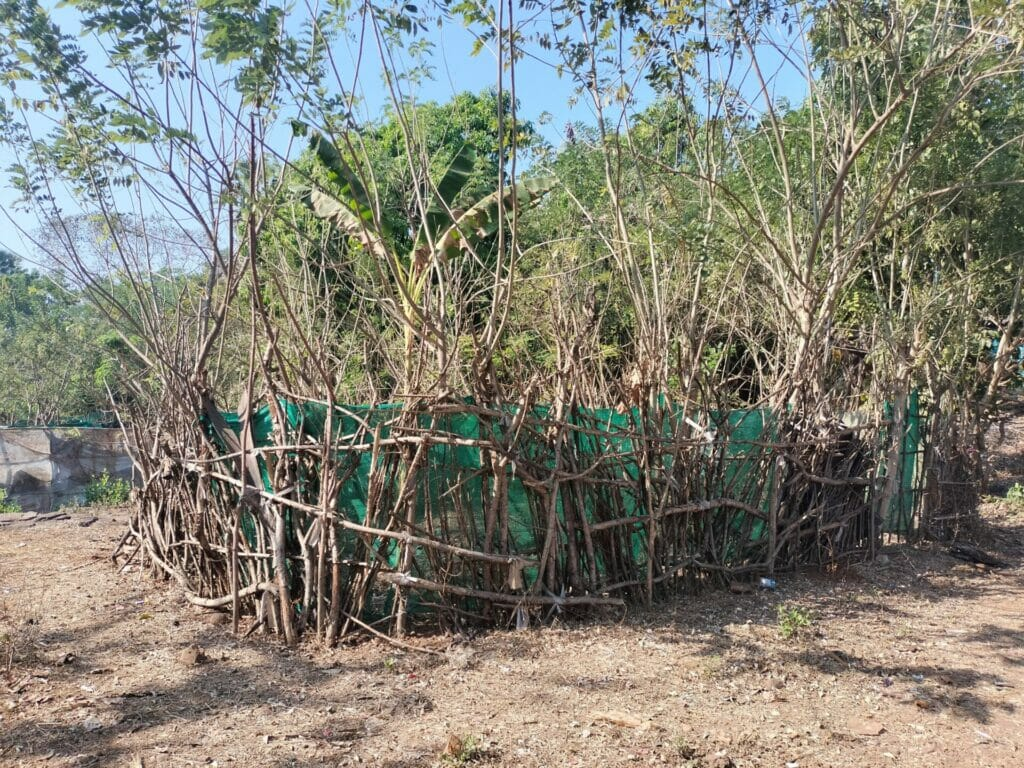
The farming cycle kicks off with the arrival of the monsoon, typically around the end of May. Warli artist and resident Dinesh Barap (2023) explains the process to CitizensMatter: “After the first rains, we dig small holes, fill them with dried cow dung and leaves, and burn this mixture to create khad (fertilizer) before planting our seeds.” The seeds they use are cherished traditional varieties, passed down through generations, allowing them to cultivate crops like cucumber, ridge gourd (shirala), bottle gourd (doodhi), and pumpkin. In addition to these vegetables, they also grow fruit trees such as custard apple, jamun, and mango.
To enrich the soil further, about ten to fifteen days after planting, the Warli farmers incorporate javla—a powder made from dried fish heads—into their soil. This time-honored practice results in a bountiful harvest, enough to sustain their families for months, with any excess sold at local markets, including those near the Borivali railway station.
Access to water is crucial for their agriculture. The Dahisar River acts as an essential irrigation source, although it can pose challenges, such as flooding that threatens to wash away crops and damage their meticulously built enclosures. During the dry season, when the riverbed is largely dry, families turn to groundwater from nearby waterholes, ensuring they have enough for both drinking and agricultural needs.
Institutional Infrastructure
The transformation of traditionally agrarian landscapes into urban centers significantly impacts agriculture, as exemplified by the experiences of the East Indian community, who have a rich legacy spanning around 400 years. Alphi D’Souza, president and spokesperson of the Mobai Gaothan Panchayat, an organization representing the East Indian community, highlights their deep roots in the Bombay region, particularly around the Salsette creeks.
Once focused on cattle rearing and agriculture, areas like Kalina village in Santacruz have seen their expansive fields replaced by urban development, now hosting a university and an army barracks. As urbanization has intensified, the East Indian community has faced numerous challenges, particularly regarding land disputes. Historical patterns of colonial and post-colonial land acquisition often left the community with inadequate compensation or forced them into unfavorable agreements.
Today, they grapple with the bureaucratic complexities imposed by entities like the Mumbai Metropolitan Region Development Authority (MMRDA), which complicates their ability to secure the necessary documentation and rights to their ancestral lands. This ongoing struggle has not only threatened their agricultural practices but also the very fabric of their identity, alienating them from a heritage intricately woven with agriculture.
Graphs
Irrigation
Cropping Metrics
Land Use and Credit
Sources
Anurag. Bhandup Koliwada. Jio Institute Exhibits.https://exhibits.jioinstitute.edu.in/spotlig…
B. Arunachalam, et al. 1986-87. Maharashtra State Gazetteers: Greater Bombay District. Vol. I, II, III. Gazetteers Department, Govt of Maharashtra. Mumbai.
Documentation of Caves in MMR. Mumbai Metropolitan Region Heritage Conservation Society.http://www.mmrhcs.org.in/images/documents/pr…
Gitanjali Gurlhosur. 2021. The Invisible Farmers of Mumbai. Mongabay India.https://india.mongabay.com/2021/07/photos-th…
HC Terminates Lease of Salt Pan Land at 782 Acres in Mumbai. Mumbai Live.https://www.mumbailive.com/amp/en/civic/hc-t…
Jyothi Shelar. 2019. Going Back to the Salt Pans of Mumbai. The Hindu.https://www.thehindu.com/news/cities/mumbai/…
Neeta Sanghi. 2018-19. Salt Taxation in Bombay Presidency 1837. Vol. 79. Proceedings of the Indian History Congress.https://www.jstor.org/stable/26906276
Puja Changoiwala. 2018. Indigenous Women in Mumbai Miss Out on India's Bank Account Drive. Women's Advancement Deeply.https://deeply.thenewhumanitarian.org/womens…
S. M. Edwardes, et al. 1909. Gazetteer of the Bombay Presidency: Bombay City and Island. Vol. I, II, III. Bombay.
Sabah Virani. 2023. Lives, Livelihoods, and Art: What Keeps Warlis Rooted in Sanjay Gandhi National Park. Citizen Matters.https://citizenmatters.in/lives-livelihoods-…
Sayantani Nath. 2019. Mumbai Mushrooms: Paintings Save Aarey Forest Milk Colony Tribal Cuisine Culture India. The Better India.https://www.thebetterindia.com/201937/mumbai…
Sherine Raj. 2023. Mumbai Aarey Tribal Family Fight for Land. Citizen Matters.https://citizenmatters.in/mumbai-aarey-triba…
The Scheduled Tribes and Other Traditional Forest Dwellers (Recognition of Forest Rights) Act, 2006. Ministry of Tribal Affairs, Government of India.https://tribal.nic.in/fra.aspx
Last updated on 6 November 2025. Help us improve the information on this page by clicking on suggest edits or writing to us.